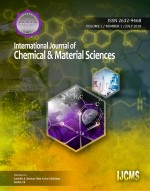An Idea for Extracting Sub-E–K Diagrams of Different Materials from a Representative Composite E–K Diagram, and Extracting Information from Time-Resolved E–K–t Plots
Keywords:
: Angle-Ressoved Photoemission Spectroscopy, Brillouin Zone, Reaction DynamicsAbstract
Chemical reactions can induce significant changes in the electronic structure of materials, leading to alterations in their electrical conductivity and magnetic properties. In this article, we explore the idea that a three-dimensional Energy–Wave Vector–Time (E–K–t) diagram – essentially a time-resolved band structure – can reveal valuable information about how a material’s electronic structure evolves during a reaction. By mapping the occupied electronic states in energy € vs. crystal momentum (k) over time (t), one can follow the electrons involved in bonding changes in real time. We discuss how such dynamic E–K–t analysis sheds light on the speed, intermediates, and extent of chemical reactions, and we introduce the concept of “reaction noise” to describe fluctuations in a material’s electronic and magnetic behavior caused by ongoing reactions. This approach provides a new perspective for understanding reaction mechanisms, with potential applications in improving material performance (e.g., conductivity and magnetism) and in developing sensors to detect reaction-induced changes. We support these ideas with recent findings in ultrafast spectroscopy and operando measurements from the literature. Finally, a comprehensive reference list of 8–10 relevant studies (from journals such as Nature, Science, RSC, IEEE, etc.) is provided to situate this work in the context of current scientific research.
Downloads
References
F. Schmitt et al., “Transient electronic structure and melting of a charge density wave in TbTe$_3$,” Science, vol. 321, no. 5896, pp. 1649–1652, 2008. DOI: 10.1126/science.1160778.
P. Wernet, “Electronic structure in real time: mapping valence electron rearrangements during chemical reactions,” Phys. Chem. Chem. Phys., vol. 13, pp. 16941–16954, 2011. DOI: 10.1039/C0CP02934C.
J. Szlachetko et al., “Real Time Determination of the Electronic Structure of Unstable Reaction Intermediates during Au$_2$O$_3$ Reduction,” J. Phys. Chem. Lett., vol. 5, no. 1, pp. 80–84, 2014. DOI: 10.1021/jz402309s.
Y. Gu, H. Yong, B. Gu, S. Mukamel, “Chemical bond reorganization in intramolecular proton transfer revealed by ultrafast X-ray photoelectron spectroscopy,” Proc. Natl. Acad. Sci. U.S.A., vol. 121, e2321343121, 2024. DOI: 10.1073/pnas.2321343121.
Y. Kim, J. Lee, “Time-resolved photoemission of infinitely periodic atomic arrangements: correlation-dressed excited states of solids,” npj Comput. Mater., vol. 6, art. 132, 2020. DOI: 10.1038/s41524-020-00398-0.
K. J. Schiller et al., “Time-resolved momentum microscopy with fs-XUV photons at high repetition rates with flexible energy and time resolution,” Sci. Reports, vol. 15, art. 3611, 2025. DOI: 10.1038/s41598-025-86660-1.
K. Hikima et al., “Operando analysis of electronic band structure in an all-solid-state thin-film battery,” Commun. Chem., vol. 5, art. 52, 2022. DOI: 10.1038/s42004-022-00664-w.
J. Bosse et al., “Angle-Resolved Photoemission Spectroscopy and Electrocatalysis: Is There a Bridge in Between?” Electrochim. Acta, vol. 524, p. 146060, 2025. DOI: 10.1016/j.electacta.2022.146060.
S. Dasgupta et al., “Intercalation-Driven Reversible Control of Magnetism in Bulk Ferromagnets,” Adv. Mater., vol. 26, no. 27, pp. 4639–4644, 2014. DOI: 10.1002/adma.201305932.
Y. Shen et al., “Evolution of the band-gap and optical properties of graphene oxide with controllable reduction level,” Carbon, vol. 62, pp. 157–164, 2013. DOI: 10.1016/j.carbon.2013.06.041.”
Published
How to Cite
Issue
Section
Copyright (c) 2025 International journal of chemical & material sciences

This work is licensed under a Creative Commons Attribution-NonCommercial-NoDerivatives 4.0 International License.
Articles published in the International Journal of Chemical & Material Sciences (IJCMS) are available under Creative Commons Attribution Non-Commercial No Derivatives Licence (CC BY-NC-ND 4.0). Authors retain copyright in their work and grant IJCMS right of first publication under CC BY-NC-ND 4.0. Users have the right to read, download, copy, distribute, print, search, or link to the full texts of articles in this journal, and to use them for any other lawful purpose.
Articles published in IJCMS can be copied, communicated and shared in their published form for non-commercial purposes provided full attribution is given to the author and the journal. Authors are able to enter into separate, additional contractual arrangements for the non-exclusive distribution of the journal's published version of the work (e.g., post it to an institutional repository or publish it in a book), with an acknowledgment of its initial publication in this journal.










